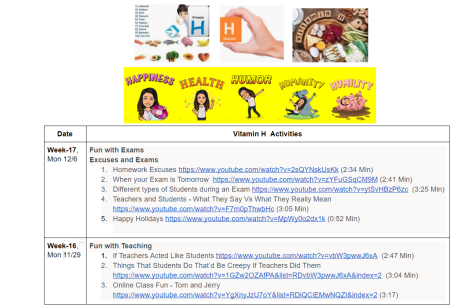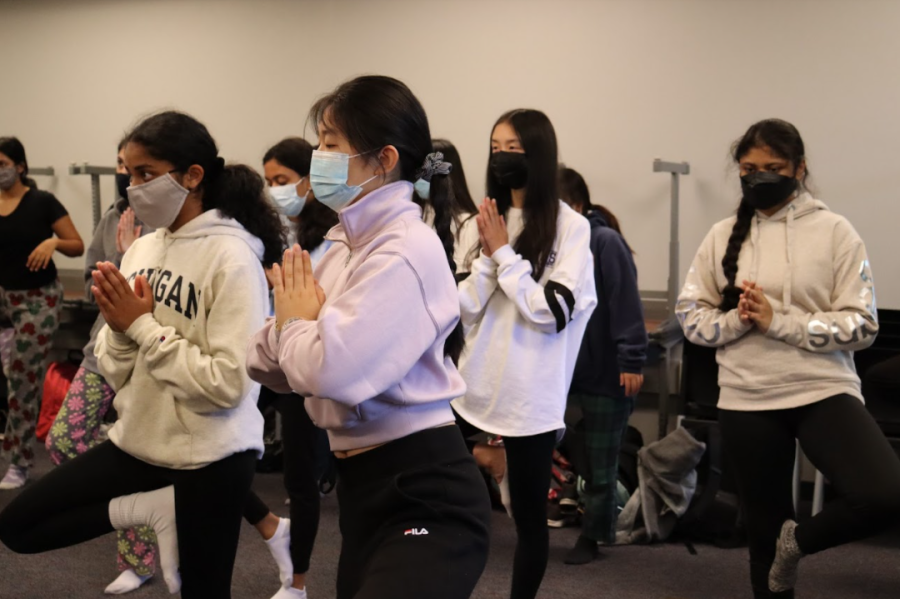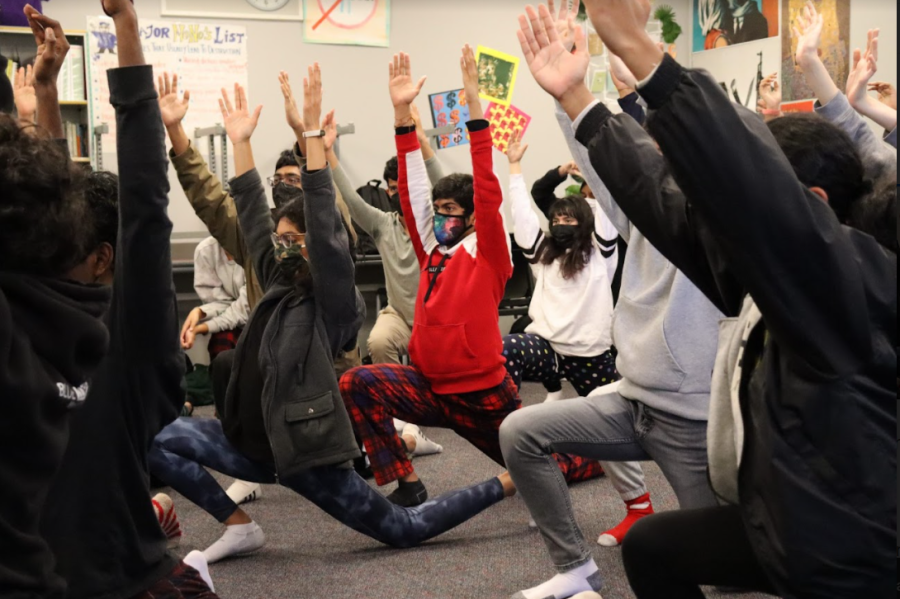Teachers implement mental health practices in classrooms
Examining how teachers directly promote self care
Junior Iona Xia stands in the tree pose.
January 24, 2022
When students walk into English teacher Vennessa Nava’s class on a yoga period or AP Physics 1 teacher Sushma Bana’s class on a Fun Friday, they have the opportunity to pause, take a deep breath and escape the stress and anxiety of school. A stark contrast to the competitive academic environment, the calm classroom environments these teachers have built highlight the importance of self care.
In 2017, Bana attended a staff development seminar at MVHS called EQ Schools: Surfing School Stress. After the seminar, she felt compelled to make a change in her class to regularly incorporate self care activities.

“I started introducing little games and five minute breaks on block days. We [called] it Fun Friday,” Bana said. “Every year when I collected feedback at the end of the year, almost all of them would always write Fun Fridays [as the most memorable] and fun.”
Some of Bana’s Fun Friday activities include watching short videos on a variety of topics, such as kindness and taking care of yourself. If there is extra time during Fun Friday, students also play fun games in order to build a classroom community. One game that Bana created was an interactive storytelling activity where each student adds a sentence to continue the plot.
Bana isn’t the only teacher who stresses the importance of mental health through engaging means. Every week during the month of November, Nava implements a self care challenge in order to allow students to pay attention to their daily habits. Nava and English and Drama teacher Hannah Gould created this challenge in November of 2020 after they noticed that students were struggling. To help them deal with heightened stress levels, Nava prompts students to reflect on the amount of sleep they got each night, acts of self care that they engaged in and their phone usage through a Google Form.
Having been in both Nava’s and Bana’s classes, junior Trisha Sreedhar has experienced two different implementations for promoting mental health awareness.
“I like both Ms. Nava’s and Ms. Bana’s idea of incorporating it into the classroom, because it’s very easy to tell students to do it outside of the classroom, [but] students [probably] wouldn’t do it,” Sreedhar said. “[However, because these teachers encourage] students [to] do it [in class], it creates a habit of prioritizing your mental health.”
In addition to the self care challenge, Nava also brings one of her favorite mindfulness practices to her classroom: yoga. Around six years ago, Nava started holding teacher yoga sessions at lunch while she was working towards becoming a certified yoga teacher. After earning her certification, she started holding yoga practice sessions for her students in all her classes.
“I usually begin [yoga days] with a spiel to frame it in a metaphor for how to move through the world in a more thoughtful way and diminish negative self-talk and the toxic competition that often characterizes our community,” Nava said. “In terms of [feedback for] the yoga, I’ve had a lot of students make comments over the years [saying], ‘Oh my gosh, I feel so much better. I fell asleep in Savasana.’ I feel like they can kind of go on with their day a little lighter.”
Similar to the mindfulness of engaging in yoga, Bana incorporates routine meditation into her testing by doing quiet deep breathing for three to four minutes and turning off the lights.
Sreedhar especially appreciates the changes that Nava and Bana have made because they teach honors and AP classes, which are associated with more homework and a tougher learning environment. She says it allows her to “think of [herself] as a person and and not just the work [she] has to do.”
Overall, Bana feels that the little changes that teachers have made reflect a larger change happening within the school community.
“I really feel happy that in our school the conversation about [mental health] has started,” Bana said. “The situation is much better than what it was a few years ago. More teachers are incorporating activities and becoming aware that this issue is important. We don’t just teach [academic] subjects — we teach human beings.”



















